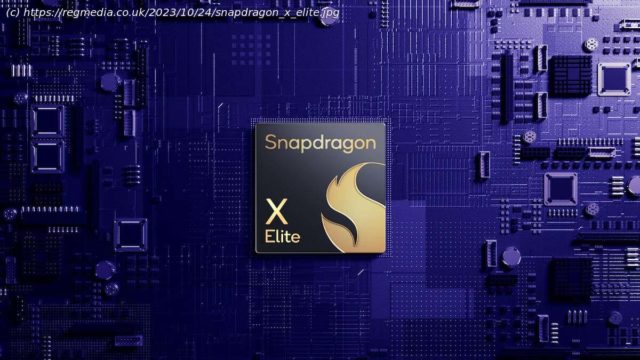Oh, and there’s a new Snapdragon 8 Gen3 chip bristling with AI potential
Qualcomm is claiming its latest PC processors are ready to go toe-to-toe with Intel, AMD, and Apple on performance and efficiency.
At the opening keynote its Snapdragon Summit on Tuesday, the San Diego-based chipmaker revealed the Snapdragon X Elite, which it claims is its most powerful system on chip (SoC) to date.
Much like Apple’s M-series processors, the X Elite is aimed at notebook and tablet form factors to woo OEMs. The chip is built on a 4nm process node and features a dozen of Qualcomm’s custom Oryon CPU cores clocked at 3.8GHz and supported by 42MB of total cache. Unlike many SoC designs, it ditches efficiency cores in favor of a boost capability, which allows up to two of the cores to hit 4.3GHz.
These cores are Qualcomm’s first developed by its Nuvia team, which it acquired for $1.4 billion in 2021. Qualcomm first teased its Oryon cores at last year’s Snapdragon Summit.
The CPU is complemented by Qualcomm’s Adreno GPU, which it claims is good for 4.6 teraFLOPS of FP32 performance — more on how the chip stacks up to the competition in a minute. The GPU can support up to two 5K or three 4K monitors at 60Hz.
The CPU and GPU are fed up to 64GB of LPDDR5x 8,533MT/s memory, though memory bandwidth is capped at 136GB/s. For reference, that’s about 36 percent more than Apple’s M2, but slower than the M2 Pro’s 200GB/s.
Alongside the CPU and GPU, the X Elite features Qualcomm’s Hexagon neural processing unit (NPU) which is good for 45 TOPS. According to Qualcomm, these features allow the chip to run AI models up to 13 billion parameter models entirely on device, and generate 30 tokens a second when running smaller 7B parameter large language models. We’ll note that these claims appear to rely heavily on Qualcomm’s own AI models developed to run on mobile devices.
As we mentioned earlier, this chip is designed to power a variety of PC and tablet hardware and thus features a configurable thermal design power (TDP) of up to 50 watts.How the X-Elite stacks up
Qualcomm is making some big claims when it comes to the performance of its X Elite chips.
In a rather nebulous series of charts — note the Y-axis which simply states “relative performance” — the company claims up to 2x higher multithreaded performance compared to the “leading” 10-core and 12-core laptop chips, or 1/3 the power consumption for the same performance in Geekbench 6.






